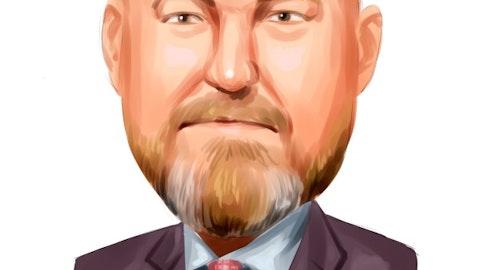Matthew Reddin: Brady, it’s Matt. I would say that’s still in line. I think we said in our last quarter that it’s going to be a front-end loaded loan growth for 2023 based on those unfunded commercial construction fundings. And when you look at our investor deck and look at Page 21, that really illustrates that. But then at the same time, I’d point you to our pipeline, as of this deck, it was right at $1 billion, and even since that point has come down even more so. So I think it’s trending that direction right now on the loan growth side.
Brady Gailey: All right. Great. Thanks for the color guys.
Jay Brogdon: Thanks Brady.
Operator: Our next question comes from David Feaster with Raymond James. Please go ahead.
David Feaster: Hi. Good morning everybody.
Jay Brogdon: Hi, Dave.
Robert Fehlman: Good morning, David
David Feaster: Maybe just following up on that last question, could you just maybe give us some detail on how demand is trending? Just where — from a geographic and segment perspective, where are you still seeing good risk-adjusted returns? And it’s nice to see the pipeline yields improve. I’m just curious where new loan yields at today? So just any other detail into the loan growth and the pipelines and all that.
Matthew Reddin: Dave, it’s Matt. Great question. I’ll give you kind of a high-level kind of comment around where loan rates are coming in. That $800 million pipeline today that we’re seeing is now at a . So I think we’re pushing through that kind of this current yield curve versus and how steep it gets so quickly that we’re kind of now cresting over that, kind of moving more into where we can catch those higher yields and still take really — our asset quality is right where it will always be. Your question around where we’re still seeing demand? Demand is definitely moderating in every market. There’s no doubt with interest rates where you’re seeing it right now, but there’s still demand. And I think there — clearly, each one of our metro markets, we’re seeing opportunities, but we’re being very selective in this environment.
We’re making sure that we’re getting a full relationship, and we’re hurdling the yields that we need to and really widening the credit spreads where we need to in this environment.
David Feaster: That’s helpful. And maybe switching to the deposit side. Obviously, a lot of uncertainty in the market and banking turmoil in March. But if I look at like the noninterest-bearing average and period end balances, it looked like a lot of this happened relatively early in the quarter. I’m just curious, as you dig into the trends, how much do you think of the deposit — the core deposit flows was really more normal business activity and clients may be migrating to higher-yielding accounts versus true impacts of that banking turmoil? And then just from — since quarter end, have you seen core deposits stabilize? Or would you expect more migration or outflows going forward?
Jay Brogdon: So David, I’d tell you that we’ve spent a lot of time this quarter dissecting everything you just asked about. And we’re having trouble convincing ourselves that it’s anything that we’re seeing is anything other than just sort of normal course activities. We’re still opening a tremendous volume of accounts all across our footprint. So everything feels very normal course. Even when we look at larger commercial moves, overwhelmingly, those are also normal course payments, and we’re seeing the typical activity that we’ve seen with those accounts historically. But absolutely, we continue to see migration to a degree within those accounts, out of NIVs as an example and the higher-rate accounts. And so you’re right, we saw a lot of that really all throughout the quarter, but including early in the quarter.
I’ll go back in time, not very far. We grew NIVs in the third quarter of last year and really had a pretty stable amount of NIVs even throughout October and early November. That trend really has picked up, that migration has picked up very late in the fourth quarter, continued in the first quarter. I’d like to think that, that’s going to stabilize here sooner rather than later. But it’s hard to have a perfect crystal ball on those migration trends. We’re certainly getting to a point on a lot of accounts where you’re just sort of the normal operating accounts or normal customer checking account type balances, which I think is more flourish than anything when you see that type of level within the customer base. But those are — that’s some color around what we’re seeing in the portfolio for the quarter.
Robert Fehlman: And David, this Bob, I’d add, if you go — as Jay said, we started — we saw this begin in December of last year in Q4. We kind of talked about it on our first quarter — or fourth quarter call, we saw all this migrate just like most other banks are early on in the quarter. And when the bank turmoil hit in the beginning of March, we were looking at and analyzing every day. We really did not see much change after that period of time. Most — all of our chains was related to this deposit mix that we’ve seen in the industry. And it’s mostly in the commercial side. The consumer side has been really relatively stable all the quarter.
David Feaster: Yes. That makes sense. And then I appreciate the color that you guys put in the slide deck on the loan portfolio and credit. Credit obviously remained solid, but we did see a modest uptick in NPAs. I’m just curious what you’re seeing on the credit front more broadly and what you’re watching and what drove that? And then any color — there’s obviously a hyper focus on office. Just curious what’s your seeing there? How your conversations with those clients are going? And just any thoughts on the overall portfolio in that office segment?
Matthew Reddin: Hi, Dave, it’s Matt. So first, kind of on your first question on the rising NPAs, it was really one specific loan that was an acquisition relationship. There’s a syndication that our — that we acquired was a part of. So it’s really isolated that drove that number up. What we’re seeing today from our asset quality is really holding up very, very strongly. We’re a lot of attention. As you can imagine, we’re focused on that every day. But I would say the only thing where we’re seeing any type of challenges are the ones similar to COVID. They were challenged before rates started moving up, and so we’re blocking and tackling harder on those relationships, but we’re not seeing things systemic in the portfolio or any specific industry or to that amount.
But on your — I would really point to you as it relates to office, in our deck, if you look at Page 20 around office and really all of our major buckets in CRE, now if you look at that office category at $1 billion, that’s 6% of our portfolio with an average loan size of $2 million, weighted average loan rate of 49%. So really, that is the continued story of who Simmons is. We’ve — while we — our office portfolio is very granular. It’s community and — it’s CPAs, it’s the insurance company in our community markets. We don’t have any large office towers or office parks where — and that are kind of which we’re also seeing in the East and West Coast versus what we’re seeing is stability in our office sector versus kind of what the coast are seeing.
David Feaster: Got it. That’s helpful color. Thanks everybody.
Operator: Our next question comes from Stephen Scouten with Piper Sandler. Please go ahead.
Stephen Scouten: Hi. Good morning, everyone. Thanks. I guess maybe if I could start just around the construction growth you guys saw this quarter. Could you give me a feel for what type of projects you’re seeing there, and kind of how you feel about your construction exposure currently?
Matthew Reddin: Steve, it’s Matt. Yes, I’ll give you what the growth we’re seeing in our portfolio is in two specific categories, in multifamily and industrial. Those are the segments that we have some proven developers, proven operators that we have had reoccurring business with and that’s where those fund-ups are happening all on time. We have a pretty robust monitoring system over that today, and we look at that very carefully. And so far, those two segments are doing very, very well. Underneath that, really, you’re going to move into a one to four construction category and then owner-occupied construction, which we love. But overall, that portfolio is funding up just like we expected it to.
Stephen Scouten: Okay. Very helpful. And then you guys note, it was in the presentation that the $330 million sub debt will go adjustable here this quarter. Can you give the margin impact of that? And then also within margin, can you — do you have any color around kind of where the marginal cost of deposits is coming on or the margin for the month of March potentially or anything like that, that would give us a feel for late in the quarter trends?
Jay Brogdon: I can tell you on the sub debt there, Steve, in that I think the rate on that for the second quarter is at 7.32%. So you could calculate the margin impact from there, I think, pretty easily.
Robert Fehlman: 5% to 7%.
Jay Brogdon: Yes, it’s going from $5 million to (ph).
Stephen Scouten: Okay. That’s perfect. And anything on kind of where the margin was in March, maybe or where cost of deposits ended the quarter at or just kind of an idea of where those marginal deposits are coming on today?





